初中英语动词八种时态
初中英语的八大时态
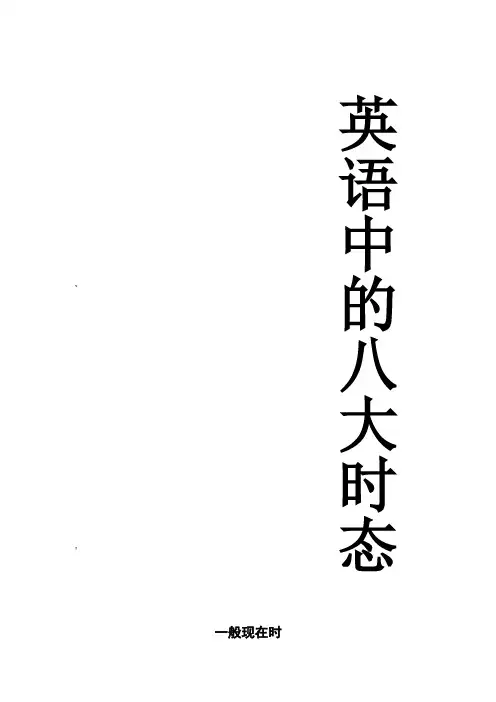
`:一般现在时英语中的八大时态定义:表示主语反复、经常、习惯性的动作。
句型结构`+V2.实义动词(行为动词)(在肯定句中,在实义动词前加do/does 用来表示强调,以加强句子的语气)2.否定句主语+don’t / doesn't+动词原形+其他3.一般疑问句Do / Does+主语+动词原形+其他4.肯定回答Yes,主语+do / does5.否定回答No,主语+don’t / doesn't用法|1.表示主语的特征或状态。
2.表示客观真理和客观事实。
3.在以when+句子,as soon as+句子,not…until, if+句子的句型中,用主将从现。
4.在以here , there 开头引导的倒装句中,通常采用一般现在时表示正在发生的动作。
时间状语(标志词)1. every+表时间n. on +星期2. 频率副词always usually often sometimes seldom never3. in the moring / afternoon / evening&形式1一般情况下,在动词末尾+s。
2以s x sh ch结尾的动词+es。
3以辅音字母加y结尾的动词,把y改为i 加es。
4以o结尾的单词有生命的+s没生命的加es。
5特殊的be 改为am is are。
&现在进行时定义表示主语的动作正在进行的句子^用法1.表示此时此刻正在进行的动作2.表示现阶段正在进行的动作或持续的状态句型结构1.肯定句:S + am/is/are + Ving2.否定句:S+ am/is/are + not + Ving3.一般疑问句:Am/Is/Are + S + Ving4.肯定回答Yes,S+ am/is/are5.否定回答NO,S + am/is/are + not>形式1如果动词以不发音字母e结尾ie,应先去e加ing2如果动词时只有一个辅音字母结尾的重读闭音节结尾,应双写该辅音字母再加ing3一般情况下,直接加ing时间状语(标志词)Look! Listen! now, at the moment, these days, can you see, can’t you see$注意事项:, come, get, go, have, leave, meet, play, return, see, spend, start, stay, wear, work等词用现在进行时表示将来。
初中英语八种时态讲解
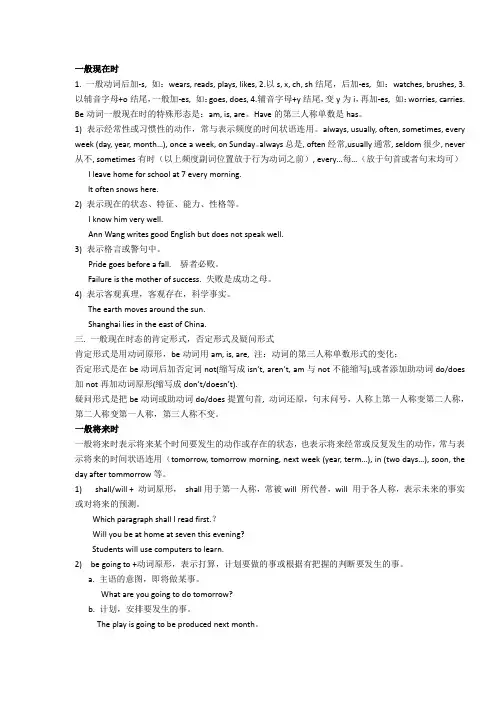
一般现在时1. 一般动词后加-s, 如:wears, reads, plays, likes,2.以s, x, ch, sh结尾,后加-es, 如:watches, brushes,3.以辅音字母+o结尾,一般加-es, 如:goes, does,4.辅音字母+y结尾,变y为i,再加-es, 如:worries, carries. Be动词一般现在时的特殊形态是:am, is, are。
Have的第三人称单数是has。
1) 表示经常性或习惯性的动作,常与表示频度的时间状语连用。
always, usually, often, sometimes, every week (day, year, month…), once a week, on Sunday。
always总是, often经常,usually通常, seldom很少, never 从不, sometimes有时(以上频度副词位置放于行为动词之前), every…每…(放于句首或者句末均可)I leave home for school at 7 every morning.It often snows here.2) 表示现在的状态、特征、能力、性格等。
I know him very well.Ann Wang writes good English but does not speak well.3) 表示格言或警句中。
Pride goes before a fall.骄者必败。
Failure is the mother of success. 失败是成功之母。
4) 表示客观真理,客观存在,科学事实。
The earth moves around the sun.Shanghai lies in the east of China.三. 一般现在时态的肯定形式,否定形式及疑问形式肯定形式是用动词原形,be动词用am, is, are, 注:动词的第三人称单数形式的变化;否定形式是在be动词后加否定词not(缩写成isn’t, aren’t, am与not不能缩写),或者添加助动词do/does 加not再加动词原形(缩写成don’t/doesn’t).疑问形式是把be动词或助动词do/does提置句首, 动词还原,句末问号,人称上第一人称变第二人称,第二人称变第一人称,第三人称不变。
8个初中英语时态
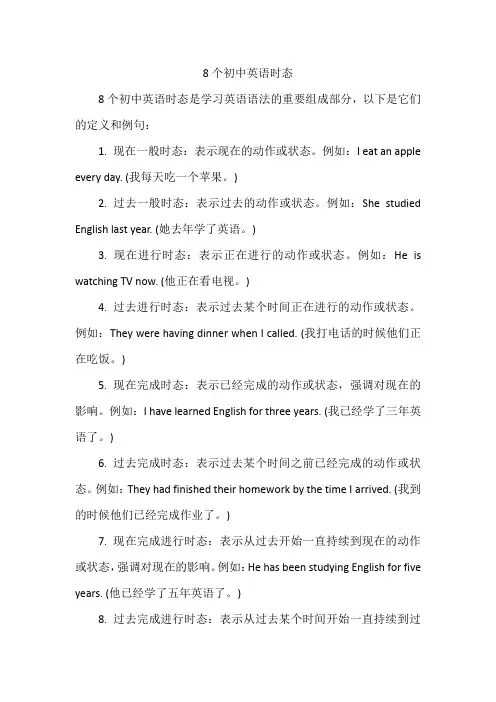
8个初中英语时态8个初中英语时态是学习英语语法的重要组成部分,以下是它们的定义和例句:1. 现在一般时态:表示现在的动作或状态。
例如:I eat an apple every day. (我每天吃一个苹果。
)2. 过去一般时态:表示过去的动作或状态。
例如:She studied English last year. (她去年学了英语。
)3. 现在进行时态:表示正在进行的动作或状态。
例如:He is watching TV now. (他正在看电视。
)4. 过去进行时态:表示过去某个时间正在进行的动作或状态。
例如:They were having dinner when I called. (我打电话的时候他们正在吃饭。
)5. 现在完成时态:表示已经完成的动作或状态,强调对现在的影响。
例如:I have learned English for three years. (我已经学了三年英语了。
)6. 过去完成时态:表示过去某个时间之前已经完成的动作或状态。
例如:They had finished their homework by the time I arrived. (我到的时候他们已经完成作业了。
)7. 现在完成进行时态:表示从过去开始一直持续到现在的动作或状态,强调对现在的影响。
例如:He has been studying English for five years. (他已经学了五年英语了。
)8. 过去完成进行时态:表示从过去某个时间开始一直持续到过去的动作或状态。
例如:They had been waiting for the bus for an hour when I arrived. (我到的时候他们已经等了一个小时的车了。
)。
初中英语八大时态归纳总结
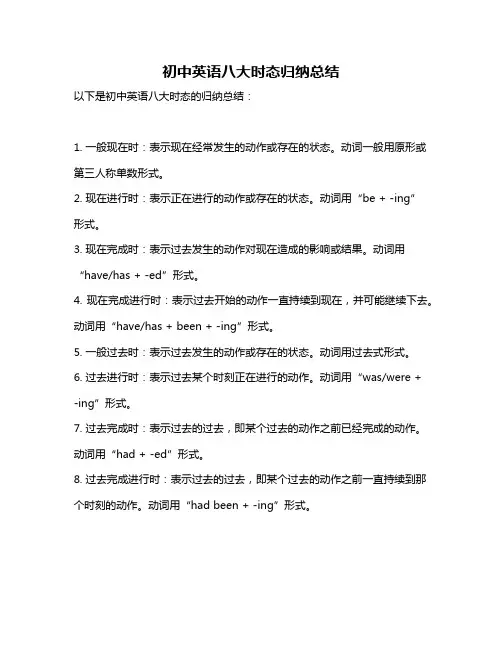
初中英语八大时态归纳总结
以下是初中英语八大时态的归纳总结:
1. 一般现在时:表示现在经常发生的动作或存在的状态。
动词一般用原形或第三人称单数形式。
2. 现在进行时:表示正在进行的动作或存在的状态。
动词用“be + -ing”
形式。
3. 现在完成时:表示过去发生的动作对现在造成的影响或结果。
动词用“have/has + -ed”形式。
4. 现在完成进行时:表示过去开始的动作一直持续到现在,并可能继续下去。
动词用“have/has + been + -ing”形式。
5. 一般过去时:表示过去发生的动作或存在的状态。
动词用过去式形式。
6. 过去进行时:表示过去某个时刻正在进行的动作。
动词用“was/were + -ing”形式。
7. 过去完成时:表示过去的过去,即某个过去的动作之前已经完成的动作。
动词用“had + -ed”形式。
8. 过去完成进行时:表示过去的过去,即某个过去的动作之前一直持续到那个时刻的动作。
动词用“had been + -ing”形式。
以上是初中英语的八大时态,理解和掌握这些时态对于英语学习和交流非常重要。
初中英语八大时态结构
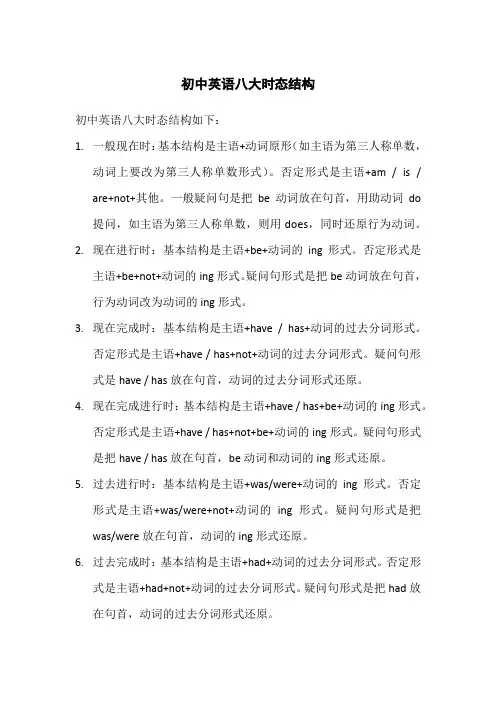
初中英语八大时态结构初中英语八大时态结构如下:1.一般现在时:基本结构是主语+动词原形(如主语为第三人称单数,动词上要改为第三人称单数形式)。
否定形式是主语+am / is / are+not+其他。
一般疑问句是把be动词放在句首,用助动词do 提问,如主语为第三人称单数,则用does,同时还原行为动词。
2.现在进行时:基本结构是主语+be+动词的ing形式。
否定形式是主语+be+not+动词的ing形式。
疑问句形式是把be动词放在句首,行为动词改为动词的ing形式。
3.现在完成时:基本结构是主语+have / has+动词的过去分词形式。
否定形式是主语+have / has+not+动词的过去分词形式。
疑问句形式是have / has放在句首,动词的过去分词形式还原。
4.现在完成进行时:基本结构是主语+have / has+be+动词的ing形式。
否定形式是主语+have / has+not+be+动词的ing形式。
疑问句形式是把have / has放在句首,be动词和动词的ing形式还原。
5.过去进行时:基本结构是主语+was/were+动词的ing形式。
否定形式是主语+was/were+not+动词的ing形式。
疑问句形式是把was/were放在句首,动词的ing形式还原。
6.过去完成时:基本结构是主语+had+动词的过去分词形式。
否定形式是主语+had+not+动词的过去分词形式。
疑问句形式是把had放在句首,动词的过去分词形式还原。
7.过去完成进行时:基本结构是主语+had+be+动词的ing形式。
否定形式是主语+had+not+be+动词的ing形式。
疑问句形式是把had 放在句首,be动词和动词的ing形式还原。
8.一般将来时:基本结构是主语+will/shall/be going to+动词原形。
否定形式是主语+will/shall/be going to+not+动词原形。
疑问句形式是把will/shall/be going to放在句首,动词原形还原。
初中英语八大时态公式
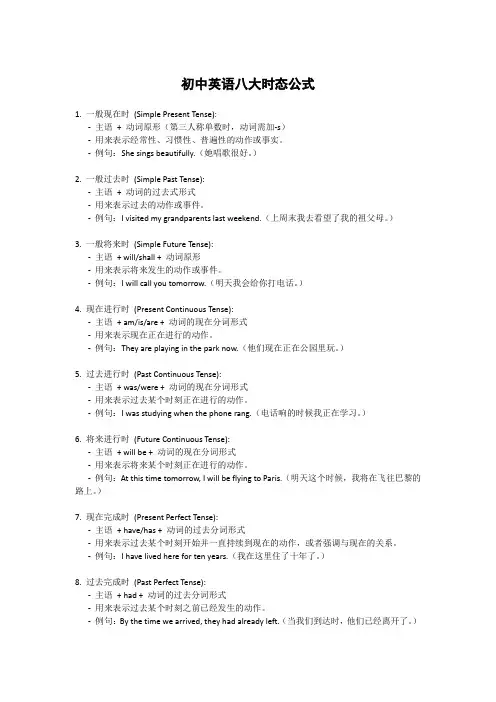
初中英语八大时态公式1. 一般现在时(Simple Present Tense):-主语+ 动词原形(第三人称单数时,动词需加-s)-用来表示经常性、习惯性、普遍性的动作或事实。
-例句:She sings beautifully.(她唱歌很好。
)2. 一般过去时(Simple Past Tense):-主语+ 动词的过去式形式-用来表示过去的动作或事件。
-例句:I visited my grandparents last weekend.(上周末我去看望了我的祖父母。
)3. 一般将来时(Simple Future Tense):-主语+ will/shall + 动词原形-用来表示将来发生的动作或事件。
-例句:I will call you tomorrow.(明天我会给你打电话。
)4. 现在进行时(Present Continuous Tense):-主语+ am/is/are + 动词的现在分词形式-用来表示现在正在进行的动作。
-例句:They are playing in the park now.(他们现在正在公园里玩。
)5. 过去进行时(Past Continuous Tense):-主语+ was/were + 动词的现在分词形式-用来表示过去某个时刻正在进行的动作。
-例句:I was studying when the phone rang.(电话响的时候我正在学习。
)6. 将来进行时(Future Continuous Tense):-主语+ will be + 动词的现在分词形式-用来表示将来某个时刻正在进行的动作。
-例句:At this time tomorrow, I will be flying to Paris.(明天这个时候,我将在飞往巴黎的路上。
)7. 现在完成时(Present Perfect Tense):-主语+ have/has + 动词的过去分词形式-用来表示过去某个时刻开始并一直持续到现在的动作,或者强调与现在的关系。
初中英语8大时态
Was I/ he/ she/ it working?
I/ He/ She/ It Was I /he/ she /it
was not working.not working?或 或I/ he/ she/ it Wasn’t I/ he/ she wasn’t working./it working?
时间状语: always, usually, often, sometimes, every week (day, year, month…), once a week,
否定形式: ①am/is/are+not; ②谓语动词为行为动词,则在其前加don't, 如主语为第三人称单数,则用doesn't,加 动词原型。
e.g.We won’t go to the park if it rains tomorrow. 如果明天下雨,我们将不去公园。
When I grow up, I will go to America. 我长大后要去美国。
动词第三人称单数 形式变化规则
规则
例子
一般在词尾加-s,(清辅音 后读/s/,在浊辅音后读 /z/;在t后读/ts/,在d后读 /dz/。)
We/ You/ They
were teachers.
Were we/ We/ You/ They Were we/ you/ they not
you/ they were not/
teachers?或Weren’t we/
teachers?weren’t teachers.you/ they teacher?
3.基本结构 主语+was/were +doing +其他 4.否定形式: 主语+was/were + not +doing+其他 5.一般疑问句: 把was或were放于句首。(第 一个字母大写) 其句式变化仍然要在be上做文章。
初中英语语法八大时态总结完整版
初中英语语法八大时态总结完整版一、一般现在时1.定义:表示经常性或习惯性的动作、状态或真理。
2.结构:主语+动词原形(+其他成分)。
3.例句:(1) I go to school every day.(2) He often plays basketball after school.(3) Water boils at 100 degrees Celsius.二、一般过去时1.定义:表示过去一些时间发生的动作或存在的状态。
2.结构:主语+动词的过去式(+其他成分)。
3.例句:(1) They visited their grandparents last weekend.(2) She lived in Beijing when she was young.(3) We studied English in middle school.三、一般将来时1.定义:表示将来一些时间将要发生的动作或存在的状态。
2. 结构:主语 + will + 动词原形(+ 其他成分)。
3.例句:(1) I will go to the park tomorrow.(3) We will have a party next week.四、现在进行时1.定义:表示现在正在进行的动作。
2. 结构:主语 + am/is/are + 动词-ing(+ 其他成分)。
3.例句:(1) She is reading a book right now.(2) They are playing soccer in the park.(3) We are having dinner at the moment.五、过去进行时1.定义:表示过去一些时间正在进行的动作。
2. 结构:主语 + was/were + 动词-ing(+ 其他成分)。
3.例句:(1) He was watching TV at 8 o'clock last night.(2) They were traveling in Europe during summer vacation.(3) We were studying when the phone rang.六、将来进行时1.定义:表示将来一些时间正在进行的动作。
初中英语语法八大时态总结(完整版)
初中英语语法⼋⼤时态总结(完整版)初中英语语法⼋⼤时态⼀.⼀般现在时1. 结构肯定句式:主语+动词原形/动词的第三⼈称单数+其他否定句式:主语+ (助动词)don't/doesn't +动词原形+其他⼀般疑问句式:Do/Does+主语+动词原形+其他简略回答:(肯)Yes,主语+do/does (否)No,主语+do/does not缩写形式: don't = do not does n't = does not例句:He often goes swimming in summer.I usually leave home for school at 7 every morning.1)表⽰经常的、习惯性的动作或存在的状态,常与表⽰频度的副词连⽤。
常⽤的频度副词有:always、often、usually、seldom、never、sometimes, every week (day, year, month …),once a week, on Su nday频度副词在句中通常放在⾏为动词之前,系动词、助动词之后。
例⼥⼝: He often goes swimming in summer.I usually leave home for school at 7 every morning.2)表⽰主语具备的性格、特征和能⼒等。
例如:All my family love football .My sister is always ready to help others .Ann writes good En glish but does not speak well.3)表⽰客观真理、客观存在、⾃然现象。
例如:The earth moves around the sun.Shan ghai lies in the east of China.4)表⽰按计划或安排好的,或将要发⽣的动作,可⽤⼀般现在时表将来。
初中英语必考八大时态结构及用法详解
初中英语必考八大时态结构及用法详解初中英语八大时态的结构及用法如下:1. 现在一般时态:基本结构为动词的原型(第三人称单数时动词后面+s, es)。
表示“现在发生的动作、情况、状态和特征”。
常与now,today,this week等时间状语连用。
2. 过去一般时态:基本结构为动词的过去式(动词的过去式在规则动词中直接在原形词尾加-d或-ed,在词尾是e的直接加d,以“辅音字母+y”结尾的动词,先将y改为i,再加-ed)。
表示“过去发生的动作或存在的状态”。
常与yesterday,last week等时间状语连用。
3. 现在进行时态:基本结构为be(am/is/are)+动词的现在分词(动词后面+ing)。
表示“现在正在进行的动作”。
常与now,at the moment等时间状语连用。
4. 过去进行时态:基本结构为was/were+动词的现在分词(动词后面+ing)。
表示“过去正在进行的动作”。
常与at this time yesterday等时间状语连用。
5. 现在完成时态:基本结构为have/has+过去分词(动词后面+ed)。
表示“过去的动作对现在造成的影响或结果”。
常与already,yet,so far等副词连用。
6. 过去完成时态:基本结构为had+过去分词(动词后面+ed)。
表示“过去的动作在过去的某个时间之前已经完成或发生的动作或存在的状态”。
常与by the end of last year,by the time of等时间状语连用。
7. 现在完成进行时态:基本结构为have/has been+动词的现在分词(动词后面+ing)。
表示“动作从过去某时开始,一直延续到现在,或者刚刚完成”。
常与for several days,since等时间状语连用。
8. 过去完成进行时态:基本结构为had been+动词的现在分词(动词后面+ing)。
表示“过去的某个动作从过去某时开始,一直延续到过去的某个时间,或者刚刚完成”。
- 1、下载文档前请自行甄别文档内容的完整性,平台不提供额外的编辑、内容补充、找答案等附加服务。
- 2、"仅部分预览"的文档,不可在线预览部分如存在完整性等问题,可反馈申请退款(可完整预览的文档不适用该条件!)。
- 3、如文档侵犯您的权益,请联系客服反馈,我们会尽快为您处理(人工客服工作时间:9:00-18:30)。
初中英语动词八种时态讲解1、一般现在时主要用于下面几情况:1) 描述当前时间内经常出现、反复发生的动作或存在的状态。
在这种情景中,句子常带有表示频率的时间状语:always , everyday , often , once a week (month , year , etc.) , sometimes , seldom , usually等等,以表示句中的动作或状态是习惯性的、经常性的。
例如:They raise ducks as a sideline .他们以养鸭为副业。
She doesn't often write to her family, only once a month. 她不常给家里写信,仅一月一封而已。
I cycle to work every day .我每天骑自行车上班。
It seldom rains here .这儿很少下雨。
2)仅为了描述状态、性质、特征、能力等等。
这里的目的是为了"描述现阶段的动作或状态",其重点"不是强调动作发生的时间、或进行的状态"。
例如:He can speak five foreign languages .他能说五种外语。
That is a beautiful city .那是座美丽的城市。
Changjiang River is one of the longest rivers in the world. 长江是世界上最长的河流之一。
She majors in music .她主修音乐。
All my family love football .我全家人都喜欢足球。
My sister is always ready to help others . 我妹妹总是乐于助人。
3) 陈述客观事实、客观真理。
顾名思义,客观的情况是"没有时间概念"的;也"不会在意动作进行的状态"。
例如:The sun rises in the east .日出东方。
The earth goes around the sun .地球绕着太阳转。
Ten minus two is eight.十减二等于八。
Light travels faster than sound .光的速度比声音的速度快。
The United States lies by the west coast of the Pacific Ocean. 美国位于太平洋西岸。
4) 根据英文语法规定,当主句的谓语动词是一般将来时,那么时间或条件状语从句的谓语动词只能用一般现在时来表示将来要发生的动作。
例如:I'll tell him the news when he comes back. 他回来时,我将告诉他这个消息。
If you take the job, they will talk with you in greater details.如果你接受这份工作,他们将和你谈谈细节。
用于一般现在时的副词,除了上面提到的一些表示频率的以外,常见的还有:now, today , nowadays等等。
2、一般过去时主要是用来描述在过去某个时候发生的动作或存在的状态。
它也可以用来表示在过去某段时间里经常发生的习惯性动作。
这一点在表达意义上与一般现在时相同,只是所在的时间区域不同而已。
由于它的主要作用如此,所以在使用一般过去时的句子里常常有一个意义较具体的过去时间状语。
这也是它与现在完成时的最大区别之一。
一般过去时由谓语动词的过去式表示,也就是说动词词末要加-ed(除不规则动词外)。
常和一般过去时连用的过去时间状语有:last night (week ,month , year , century , etc.) , yesterday , the day before yesterday , yesterday morning ( afternoon , evening ) , in 1999 , two hours ago ( one week ago , tree years ago , …)等等。
使用一般过去时,在某种意义上说就是要强调动作或状态发生或存在于过去的某个时候。
"过去"的时间概念有两层意思:一是指"现在某个时间"以前的时间;二是指"说话、写文章的那个时间点"以前的时间,在这个意义上,"现在的那个时间点"是很小很小的,甚至于小到无法量化的程度。
例如:He got his driving license last month. 他上个月拿到了驾照。
--Where's Jim? 吉姆在哪里?--He just went out.他刚刚出去。
3、一般将来时主要用来描述将要发生的动作或存在于未来的情况。
这里所说的"将来时间"是指"说话、写文章那一刻以后的时间"。
它的表示方法主要有如下几种:1)shall / will + 动词原形这种表示方法是说,动作在现在或目前还未发生,要在将来的某个时间内发生;它没有主观性,是"纯粹的将来动作"。
例如:I shall / will not be free tomorrow .我明天没空。
He will arrive here this evening .他今晚抵达这里。
2) be( am / is / are ) + going +不定式这种表示方法主要是说明A)"说话人的意图、打算";B)"某种可能性" 。
例如:A) He is going to spend his holidays in London . 他打算在伦敦度假。
Who is going to speak first? 谁先发言?B) It is going to rain soon .马上要下雨了。
Is he going to collect any data for us? 他会帮我们收集资料吗?If you go to New Zealand, you are going to like the place. 如果你去新西兰,你会喜欢上那个地方的。
3) be( am / is / are ) + 不定式表示方法描述两钟情况:按计划安排要发生的动作,这个动作发生的时间一般不会很远;要求或命令他人做某事。
例如:A) The new bridge is to open to traffic in three days. 新桥三天后通车。
The factory is to go into production before National Day. 这家工厂国庆节前投产。
B) You are not to bring any mobile communication means into the exam-room . 任何移动通讯工具都不得带入考场。
You are to stay home until your mother comes back. 你妈回来之前你不要出去。
4) 用一般现在时或现在进行时(限于某些动词)表示按计划安排要发生的事。
这种表示方法实际上已经在上面"一般现在时之4)"中谈过。
主要强调"按计划安排要发生的事"。
例如:Do you get off at the next stop? 你下一站下车吗?The plane takes off at 11:00 a.m. 那架飞机上午十一点起飞。
Mr. Reider is leaving for New York next week. 里德先生下周动身去纽约。
4、过去将来时表示过去的某时以后将要发生的动作。
但这个"将来"时间绝不会延伸到"现在";而仅限于"过去时间区域内"。
由此可以看出,含这个时态的句子常带一个表示"过去某个时间点"的状语。
这个状语或是一个短语,或是一个句子。
这个时态常用于:A)宾语从句或间接引语中;B)表示过去习惯性的动作;C)表示过去情况中的"愿望"、"倾向",多用于否定句。
例如:A) When I thought about it , I wondered what their reaction would be . 当我考虑这件事时,我想知道他们的反应是什么。
She told me that she would go on trip to Europe the next day. 她告诉我,她第二天要去欧洲旅行。
He didn't expect that we would all be there. 他没料到我们会全在那儿。
B) During that period , he would do morning-exercises every day. 在那段时间,他每天早锻炼。
Whenever he had time, he would help his mother with some housework. 无论他什么时间有空,他总是帮他妈妈干点家务活。
C) No matter how difficult the work was , he would keep on doing it until he accomplished it . 不管工作有多难,他总会坚持不懈地把它干完。
They knew that we would never permit such a thing. 他们知道我们绝不会允许发生这样的事。
Even after the lecture ended, the audience would not leave . 甚至在讲座结束之后,听众仍不肯离去。
5、现在进行时主要用来描述"说话、写文章的当刻"正在发生的动作,或是"现阶段"一直在进行的动作。
它适用于下面的情况:1)"说话、写文章的当刻"正在发生的动作。
例如:They are having a football match .他们正在赛足球。
She is writing her term paper. 她正在写学期论文。
Someone is asking for you on the phone. 有人找你听电话。
2)"现阶段"一直在进行的动作。
这种情况并不是说某个动作在说话的那会儿正在发生,而是说某个动作在当前一段时间内一直在进行着,或是重复地发生着。
